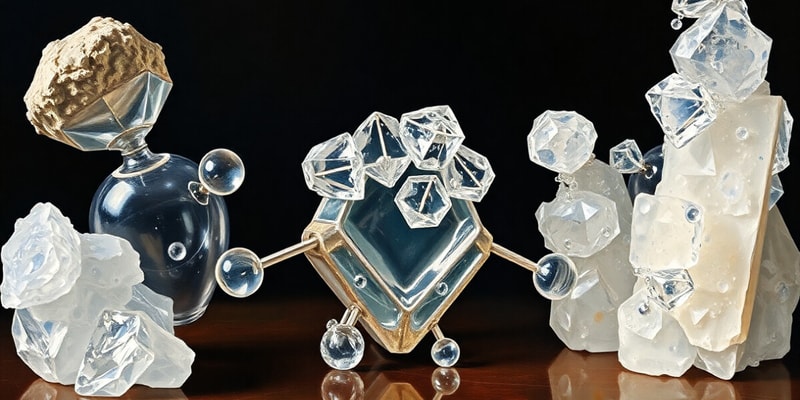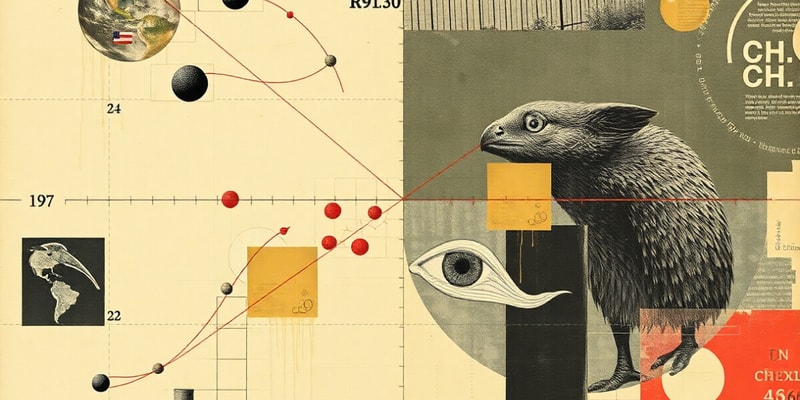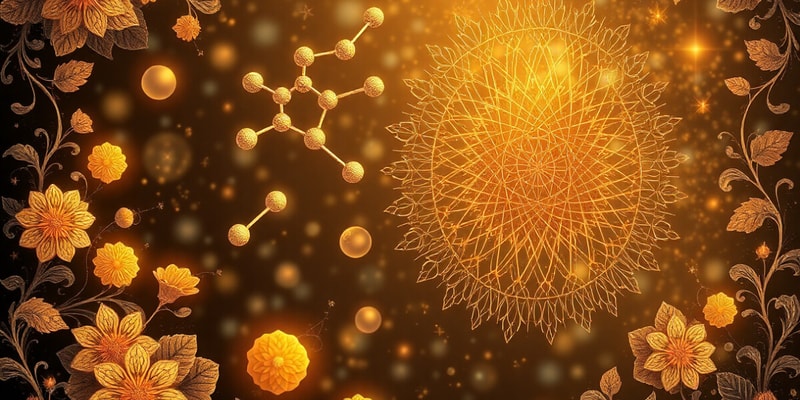Podcast
Questions and Answers
The term equivalent to a concentration term in an equilibrium constant is [A]a, where [A] represents the ______ of component A.
The term equivalent to a concentration term in an equilibrium constant is [A]a, where [A] represents the ______ of component A.
activity
For an ideal gas, the equivalent equation for a real system is given as 𝜇𝑖 = 𝜇𝑖° + 𝑅𝑇 ln ______.
For an ideal gas, the equivalent equation for a real system is given as 𝜇𝑖 = 𝜇𝑖° + 𝑅𝑇 ln ______.
a𝑖
It is activities rather than ______ that should strictly be used in expressions of equilibrium constants.
It is activities rather than ______ that should strictly be used in expressions of equilibrium constants.
concentration
The relationship between activity and concentration is given by the equation ai = ______i[i].
The relationship between activity and concentration is given by the equation ai = ______i[i].
Signup and view all the answers
The activity coefficient of component i is represented by ______.
The activity coefficient of component i is represented by ______.
Signup and view all the answers
The free energy equation is given as ∆𝐺 = ∆𝐺 ° + 𝑅𝑇 ln ______.
The free energy equation is given as ∆𝐺 = ∆𝐺 ° + 𝑅𝑇 ln ______.
Signup and view all the answers
The equilibrium constant is expressed as K = ______, representing the activities of the reactants and products.
The equilibrium constant is expressed as K = ______, representing the activities of the reactants and products.
Signup and view all the answers
The proportionality constant in the equation linking activity and concentration is called the ______.
The proportionality constant in the equation linking activity and concentration is called the ______.
Signup and view all the answers
In real systems, activities can be approximated by ______ depending on the circumstance.
In real systems, activities can be approximated by ______ depending on the circumstance.
Signup and view all the answers
∆𝐺 ° is defined as the free energy under ______ conditions.
∆𝐺 ° is defined as the free energy under ______ conditions.
Signup and view all the answers
Many pharmaceutical compounds display multiple crystalline solid state forms known as crystal ______.
Many pharmaceutical compounds display multiple crystalline solid state forms known as crystal ______.
Signup and view all the answers
Stability of crystal forms can vary with ______.
Stability of crystal forms can vary with ______.
Signup and view all the answers
Affects solubility and other key ______.
Affects solubility and other key ______.
Signup and view all the answers
The phase diagram for a compound with two crystal forms has two solid regions, ______ and S2.
The phase diagram for a compound with two crystal forms has two solid regions, ______ and S2.
Signup and view all the answers
For a system, G = f(P, V, ______).
For a system, G = f(P, V, ______).
Signup and view all the answers
For an ideal system, total G = GA + GB + ______.
For an ideal system, total G = GA + GB + ______.
Signup and view all the answers
The contribution of each component to the overall free energy is signified by its chemical ______.
The contribution of each component to the overall free energy is signified by its chemical ______.
Signup and view all the answers
Recall, for a process at equilibrium: ΔG° = −RTln______.
Recall, for a process at equilibrium: ΔG° = −RTln______.
Signup and view all the answers
There is a similar equation for an ideal ______.
There is a similar equation for an ideal ______.
Signup and view all the answers
N is the number of ______ of the gas.
N is the number of ______ of the gas.
Signup and view all the answers
Study Notes
Polymorphism
- Many pharmaceutical compounds can have multiple solid state forms called polymorphs.
- These polymorphs have different stability depending on temperature.
- Paracetamol has at least three polymorphs.
- Drugs can also have amorphous (non-crystalline) solid forms.
- The crystal form of a drug affects its solubility and other properties.
- These properties must be controlled to ensure correct drug delivery and function.
Phase Diagrams
- A phase diagram can be used to represent the stability of different polymorphs.
- These diagrams are similar to basic one component phase diagrams but include regions for each polymorph.
- The most stable polymorph will depend on the conditions, such as temperature and pressure.
Chemical Potential
- Chemical potential (μ) is a measure of the contribution a component makes to the overall free energy of a system.
- For a real system, changes in composition, temperature, or pressure depend on the interactions between all components.
- For a system with three components (A, B, and C), the total free energy (GT,P) is calculated as: 𝐺𝑇,𝑃 = 𝜇𝐴 𝑛𝐴 + 𝜇𝐵 𝑛𝐵 + 𝜇𝐶 𝑛𝐶.
- This equation shows the contribution of each component's chemical potential to the overall free energy.
Free Energy Changes in Real Systems
- In a real system, the free energy change (ΔG) is not equal to the standard free energy change (ΔG°) and is related to the equilibrium constant (Keq) by the following equation: G − G° = RTlnKeq.
- For an ideal gas, the free energy change (ΔG) is related to the standard free energy change (ΔG°) and pressure by the following equation: ΔG = ΔG° + RTln(P/P°).
- The pressure term (P/P°) can be considered equivalent to a concentration term ([A]a) commonly found in the equilibrium constant.
Free Energy Changes in Real Systems
- For a real system like a solution, the chemical potential (μi) of a component (i) can be described with this equation: 𝜇𝑖 = 𝜇𝑖° + 𝑅𝑇 ln 𝑎𝑖, where ai is the activity of component i.
- Activity (ai) reflects the effective concentration of a species in a solution, accounting for non-ideal behavior. It's not always equal to the actual concentration.
- Activity is directly proportional to concentration ([i]) with the proportionality constant being the activity coefficient (gamma).
Free Energy Changes in Real Systems
- The activity coefficient (γi) accounts for the non-ideal behavior of a solution.
- For a process involving components A, B, C, and D, where components A and B react to form components C and D, the free energy can be expressed as: ∆𝐺 = ∆𝐺 ° + 𝑅𝑇 ln 𝐾.
- The equilibrium constant (K) for this reaction is given by: 𝑎𝐶𝑐 𝑎𝐷𝑑 / 𝑎𝐴 𝑎𝐵.
- In practical applications, activities can often be approximated by concentrations, especially when the deviations from ideality are not significant.
Studying That Suits You
Use AI to generate personalized quizzes and flashcards to suit your learning preferences.
Related Documents
Description
This quiz explores the concept of polymorphism in pharmaceutical compounds, including the properties and stability of various polymorphs. It covers phase diagrams and chemical potential relevant to the behavior of drugs in different solid forms. Test your understanding of these critical topics in drug formulation and stability.




